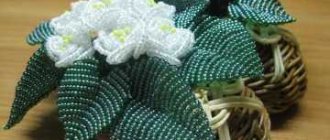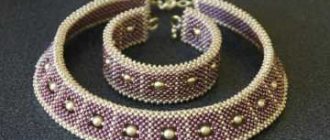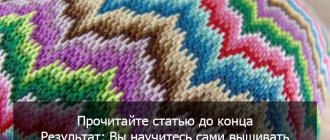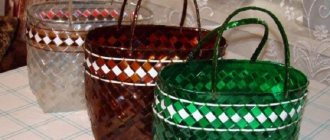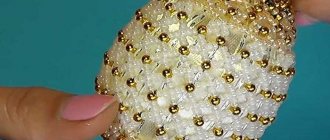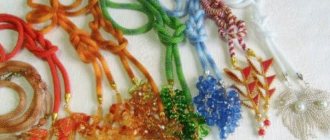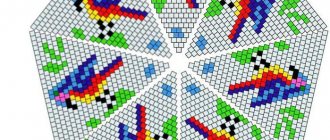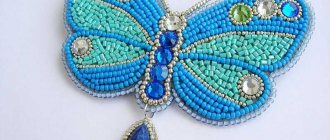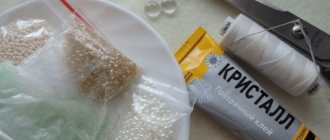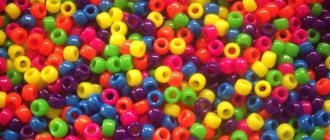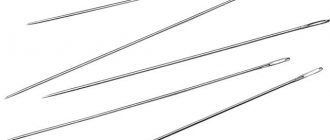Needlework
05/01/2018 Anastasia Prozheva
Gerdan (or gaitan) is a neck decoration woven from beads. The Russian name gaitan meant a string, a woolen thread on which a cross or an icon was hung. Gaitan is a decoration originating from Ukrainian villages, where craftswomen made luxurious medallions connected together with beaded strips. Each element of the ornament had a deep meaning and different areas used their own patterns. We invite you to weave a gerdan from beads, using the patterns provided in the article; this activity will bring you considerable pleasure. The result will be a magnificent decoration that evokes notes of antiquity, but at the same time has not lost its relevance in our time. After all, the time-forgotten ethnic style, combining echoes of the ornaments created by our ancestors, is once again at the peak of fashion.
Bead history
The cradle of beads is Ancient Egypt, where craftsmen managed to obtain glass for the first time. Over time, people learned to create small beads. They were used to decorate the clothes and household items of wealthy nobles. Initially, all products were made using a base, and after the invention of mesh binding, craftsmen had the opportunity to make independent jewelry.
Gradually, “busra”, i.e. artificial pearls, appeared in Europe. Although the uneven, cloudy beads could hardly be called pearls. Italian craftsmen have improved glass production technology, bringing it to almost perfection. It is not for nothing that Bohemia is still considered the center of glass making. They tried to hide the secret of production within the factory walls on a separate island - Murano. But even the threat of the death penalty did not keep production secrets, and glass factories gradually appeared in other European cities.
Italian, Czech and Japanese beads are considered to be of the highest quality. Manufacturers make it perfectly smooth, calibrated in size, bright and very resistant to abrasion. To create high-quality jewelry, it is better to choose material from these manufacturing countries.
Related article: Flowers using quilling technique for beginners: patterns with photos and videos
Why do craftswomen value tiny beads so much? They allow you to create unique things that are not afraid of the passage of time. This is evidenced by the records of archaeologists who discovered small green beads in almost perfect condition in ancient Egyptian tombs. At the moment, these products are over 5.5 thousand years old.
Ways to wear
By tying the lariat in different ways, you can change the shape of the decoration. It can be long or short, there are many tying options.
- The necklace is easy to make by wrapping the rope around your neck twice and fastening the clasp a third time.
- Sometimes the lariat is tied with a simple knot, leaving the ends 7-10 cm hanging, which looks nice.
- You can make a pendant necklace by folding the rope in half and bringing the loose ends through the neck.
- A twisted necklace is also easy to make. The tourniquet is placed loosely on the chest from the front side, the ends are brought behind the neck. The ends are wrapped around the part in the middle, which lies on the chest, pointing towards the center and left hanging beautifully.
For original knots, you can use the diagrams, this includes the Josephine knot, a braid necklace, and other options.
So, a beaded lariat is an ideal option for everyday wear. By changing the shape and tying method, you can create a new decoration by diversifying your outfit.
https://youtu.be/mp4p55N-nyIhttps://youtu.be/nVCUqYMEx7Y
_
Weaving techniques
To weave a beautiful gerdan, you will need:
- special machine;
- high-quality beads (preferably Czech);
- monofilament;
- beading needle;
- scissors.
Many craftswomen prefer to weave the old fashioned way, without a machine. At the same time, the fabric turns out softer and flows. The convenience of this method lies in the fact that there is no need to hide a large number of threads.
Gerdan consists of two parts - a medallion and a beaded ribbon.
The ribbon can be made as a separate piece, consist of two parts, or be connected to the medallion during the weaving process. If the parts are woven separately from each other, they are connected using threads studded with beads.
To create a gerdan, the bead weaving technique is used. It consists of stringing a certain number of beads and their color ratio (in accordance with the chosen scheme). In the second and all subsequent rows, the beads are strung one at a time in accordance with the pattern. For weaving, craftswomen use the following low pattern.
The master class, filmed on video, will help you master this technique with ease.
You can see the step-by-step process of assembling the canvas in the photo instructions:
Working on special equipment
To work on creating jewelry, you can use a purchased machine or make it yourself. Making gerdan on a machine is simple. You can make homemade equipment with your own hands. To do this, glue the following structure from cardboard:
Make small slits at the base of the sides and reinforce the threads. Their number should exceed the number of beads in the pattern by one unit. The length of the thread should correspond to the arm span.
Related article: Pine branch with paper cones. Master Class
In this master class the following weaving pattern is used.
Attach a needle with a working thread to the cardboard, leaving a tail of 15 cm. Thread beads onto it in accordance with the pattern.
Distribute the beads so that each bead is between the warp threads.
Pass the needle through the cast-on row so that it passes over the warp threads. Lightly stretch the working thread.
The further set of rows is carried out similarly. The machine weaving method is ideal for beginning craftsmen, as it combines simplicity and speed of set-up.
The new thread is secured by passing it through the previous row of beads several times. The tail is hidden inside the canvas. Having reached the expansion of the pattern, you need to add working threads. To do this, thread an additional thread through a second needle and pull it through a row of beads, align and secure the ends on the loom.
Continue weaving according to the pattern.
The decrease is done by passing the edge warp threads.
When part of the gerdan is ready, it is removed from the homemade loom and connecting beads are strung. Then they are fixed again on the loom and weaving continues according to the pattern.
When both halves of the necklace are woven, they are removed from the loom and joined together with low beads. You can see the result in the photo.
The ethno-style decoration is ready.
What is a bead lariat?
It is represented by a long neck decoration in the form of a large transforming cord. Fashionistas love it for its versatility and the ability to create different looks with one accessory. The lariat can become a neat necklace, an elegant sautoir, a short necklace, a belt or a bracelet.
The appearance of the decoration is determined by the pattern or techniques of making it in the form of a rope:
- openwork;
- twisted;
- spiral.
It is distinguished by a feature represented by dense, elastic weaving. The master class given in the article will help you perform a lariat from beads.
Selection of patterns
We offer you a small selection of patterns for weaving gerdan. They will help in creating jewelry with Ukrainian motifs, as well as its more modern variations.
